The Confluence Fall 2024





On a crisp October morning the roaring and buzzing of chainsaws cut into the frosty silence at the Condon Work Center. For 24 years Swan Valley Connections (SVC) staff and volunteers have gathered to buck, split, deliver, and stack firewood for community members. This year 30 people prepared and delivered 32 truckloads of wood to those in need, a new record for this long-standing tradition.
The firewood comes from timber harvested in local thinning projects. These logs are then transformed from a heightened wildfire risk into a renewable resource, warming the homes of residents throughout the valley. Community Firewood Day reminds us that living on a working landscape poses many challenges, but those challenges are easier to overcome when people work together. Collaborative conservation is the heart of what we do at SVC, and we are grateful that we have had the opportunity to gather people at the Condon Work Center for the past 30 years.

In our last issue of The Confluence, we described the history of the Condon Work Center and the U.S. Forest Service (USFS) presence in the Swan Valley. We also let readers know that the USFS is considering selling (or conveying) the Condon Work Center and has asked Swan Valley Connections to move out at the end of our annual partnership agreement, which concludes on March 1, 2025. As I write this, the USFS is still exploring the possibility of conveyance. Their main objective is to relinquish responsibility for maintaining the facility, which they estimate to have 1-2 million dollars of deferred maintenance. If they decide not to convey the property, they will explore other possibilities to share the responsibility of keeping up the infrastructure with a partner.
We at Swan Valley Connections are invested in a future where the Condon Work Center continues to be managed for conservation and community benefit. We are also committed to continuing our services to the community. We recognize that many of the resources, offerings, and programs that you have come to know and respect require a physical space. This includes holding public meetings such as Firesafe Swan, connecting with landowners to answer questions about land management or living with wildlife, visitor services and education, and so much more. For our work to continue, SVC needs a secure place to call home, where we can connect with the community and our partners.
We are excited to announce that we have identified a property that could provide SVC with a safe and permanent home for our future – empowering us to invest deeper into this special landscape and better deliver on our mission. Stay tuned for updates in December.
With Hope and Excitement for the Future,

Lamar, Managing Director- Education and Connections
p: (406) 754-3137
f: (406) 754-2965
info@svconnections.org
Mary Shaw, Chair
Jessy Stevenson, Vice-Chair
Donn Lassila, Treasurer
Rachel Feigley
David Holmes
Dan Stone
Rich Thomason
Aaron Whitten
Tina Zenzola
Emeritus
Russ Abolt
Anne Dahl
Steve Ellis
Melanie Parker
Tom Parker
Maria Mantas
Neil Meyer Rebecca Ramsey
Advisors
Kvande Anderson
Steve Bell Jim Burchfield
Larry Garlick
Steve Kloetzel
Chris La Tray
Leake
Tim Love
Alex Metcalf
Pat O’Herren
Casey Ryan
Mark Schiltz
Lara Tomov
Mark Vander Meer
Gary Wolfe Staff
Luke Lamar, Managing Director
Sara Lamar, Managing Director
Ty Tyler, Managing Director
Andrea DiNino
Kirsten Frazer
Mike Mayernik
Jackie Pagano
Uwe Schaefer Taylor Tewksbury

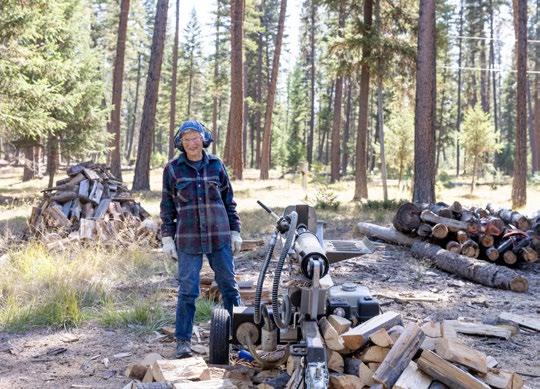


“Can we coexist with wild nature?
How can grizzly bears, wolverines, lynx, and bull trout
thrive alongside our human communities?

Swan Valley Connections has been answering these questions for decades with place-based expertise. By supportinig SVC, you’re enabling the ongoing wildlife research and the building of community relationships necessary to allow the wildest members of nature to thrive alongside modern humans.”
- Photo and words by Steven Gnam, Wildlife Photographer
November 1-30, 2024
fundraising Goal: $40,000
By Taylor Tewksbury
On a snowy morning in early December, eight participants from Missoula to Bigfork gathered at the SVC office for a day of wildlife tracking. SVC’s Conservation Director, Luke Lamar, led the group in a round of introductions, and each participant talked a bit about their journey with tracking. Sipping hot cocoa from a thermos, even our youngest tracker, who was just five years old, shared his excitement for the day ahead. Then, brushing snow from our jackets, we piled into the rig and headed out to our first stop.
Snow quickly blanketed the ground with each passing minute, covering tracks left earlier that morning. We can only laugh. It seems as though the forecast has eyes on our events calendar, as fresh snow seems to like to fall right before or during our classes, making for challenging tracking conditions. And yet, without fail and similar to this December day, we always seem to find exciting sign and have memorable days.
Beneath the shelter of outstretched evergreens, we huddled around the first track. Getting to work and compiling clues, Luke highlighted the animal’s leading toe, a characteristic of the felid family. Noting the impressive size of the print and animal’s long stride (or length between tracks), the group
concluded it must belong to the valley’s largest elusive feline: the mountain lion. Ducking between low-lying branches, we followed the tracks until they disappeared into the forest understory. As the group turned towards the cars, one participant yelled out as a grouse flushed from its hiding spot. In its hastened escape, the bird left behind a parting gift: a fresh set of tracks for the group to look at before moving on to our next destination.
As we drove down the road, we idled the rig along a line of snowed-in tracks that continued on as far as we could see. Could it be a human out on an early winter stroll? No, the stride was too long. A large canine? No again. Whoever had trudged down this road had left behind large, pigeon-toed prints. As the group paced pensively along the tracks, Luke guided them through a mental dichotomous key of possible suspects. With each question, the group slowly came to a consensus: grizzly bear, one of our less common winter tracking subjects. As participants jotted down stride measurements for later use, our youngest tracker dropped on all fours and practiced his lumbering overstep walk.
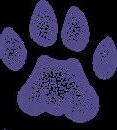
“Luke parted a tangle of stiff willow branches, careful not to spill snow into the scene.
The group peered in as he revealed a freshly stashed deer carcass.
Who would have hid their calories in the bushes?”


After warming up chilled digits on the ride to the next stop, the group arrived at the brushy edge of a wetland. Luke parted a tangle of stiff willow branches, careful not to spill snow into the scene. The group peered in as he revealed a freshly stashed deer carcass. Who would have hid their calories in the bushes? Again, it was one of our powerful top predators, the mountain lion. Mountain lions cache their kills, piling duff and debris atop the carcass to keep birds and other scavengers from stealing their hard-earned meal. Pulling a bone saw from his pack, Luke explained to the group that the health of a deer at its time of death can be determined by examining the marrow. Luke cut into the leg of the doe, revealing fatty marrow indicative of a relatively healthy animal. Our young tracker observed intently, munching a cookie.
Restoring the lion’s cache to its original state, the group returned to the Suburban and made their way to the Elk Creek Conservation Area, one of the properties SVC manages in partnership with the Confederated Salish and Kootenai Tribes. As the group walked through the forest, Luke pointed out sign after subtle sign etched into the bark of the trees. With his rosy nose held just inches from a conifer’s trunk, a participant ran his fingers over a rough section of pale inner wood. Resin leaked from the scar where a chunk of bark had been ripped from the tree. As the group considered multiple explanations, Luke finally described the importance of scent marking in bear communication. To announce their presence to others, a bear will stand tall and vigorously rub their scent into a tree, often urinating as they work their shoulders, neck, and head into the bark. Bears leave their scent in even
more ways while performing this behavior: they will stomp their pedal (foot) scent glands into the ground or reach back and bite into the trunk, tearing off chunks of bark in the process. Like the bears who had visited the tree before them, the group then continued on their way down the old road.

As we dropped down to the creek’s edge, the valley had a few final surprises to share. Participants peered into a belted kingfisher’s nesting burrow, which the bird had excavated from an earthen bank. Across the creek, a long slide mark along the ice vanished into the water, revealing the preferred transportation method of a river otter. As the group prepared to turn towards home, a participant quickly motioned towards a flash of dark brown, which disappeared under a snowcovered root wad. Drawing in to investigate, we followed the tracks as the critter dashed between piles of woody debris along the creek’s edge. Upon examination of the tracks, the group concluded that the animal was loping across the snow, a gait pattern characteristic of our culprit, the mink, and other mustelids. Crouched near a break in the icy surface, participants noted where the small, semi-aquatic carnivore had slipped away into the creek.
Bouncing back down the road to the office, surrounded again by the warmth of the vehicle, we were reminded of some important lessons. No matter how long you’ve been tracking (or how long you’ve been on this earth), exploring the landscape with others always offers the chance to learn something new. And, despite often challenging conditions, the Swan Valley never fails to provide opportunities for curiosity and awe.
Track illustrations by Eli Estey
Opposite: Mountain lion
Above: Northern flicker
Opposite: A winter tracking class following tracks along the Swan River.
Right: Going over the characteristics of felid vs canid tracks after the class narrowed down the possible suspects for these large, long-stride prints. The culprit? A mountain lion.
Check out all of our 2025 (and December 2024) wildlife tracking opportunities on the following page!





Interested in tracking with us? Check out these upcoming opportunities with SVC. If the event you would like to join is full, you can still join the waitlist! Need financial assistance? Scholarships are available and can be found on our website. Don’t see dates that work for you? Contact us to set up a custom tracking experience for your group.
Wildlife Track & Sign One-Day Workshops
Learn how to read tracks and sign to determine the movements and behaviors of animals in the Swan Valley and beyond. Hone your eyes to subtle clues with the help of experienced guides in this 1-day introductory class.
Dec 14, 2024
Jan 18, Feb 15, March 8, 2025
Hone your ability to find and follow animal trails over long distances. Each participant will have the opportunity to be the lead tracker, piecing together sign to follow a continuous trail. Trailing is a crucial skill for hunters and those wishing to connect deeply to individual animals. We are offering both a workshop (up to 6 participants) and a trailing certification (4 participants). During the certification process, participants will be scored on their ability to follow a trail.
June 13 Trailing workshop with Luke Lamar- FULL, join waitlist
June 14-15 Standard Trailing certification with David Moskowitz- FULL, join waitlist
June 16-17 Standard Trailing certification with David Moskowitz- FULL, join waitlist
Wildlife Track & Sign Certification
Dive into the art and science of tracking with a two-day workshop. These certifications are both an evaluation and an immersive learning experience. There is no previous experience required for a standard certification. It is recommended that you have a score of at least 97% to sign up for a specialist evaluation.
June 19-20 Track & Sign Specialist with David Moskowitz and Casey McFarland
June 21-22 Track & Sign Standard with David Moskowitz
Wildlife Track & Sign Weeklong Course
Fully immerse yourself into the world of tracks & sign in this weeklong course. Each day will begin with time in the classroom covering foundational concepts, and the remainder of the day will be spent outdoors experiencing as many tracks & signs as we can find. This course includes five days of instruction and a two-day certification and can be taken for 2 University of Montana Wildlife Biology credits. Airport pick-up, food, and lodging are included.
January 4-12 (evaluation with Michelle Peziol)
March 15-23 (evaluation with Michelle Peziol)


The seasonal round refers to the cyclical pattern of resource utilization and subsistence strategies practiced by indigenous communities, as they adapt to the seasonal availability of food and other resources in their environment.
In our Montana Master Naturalist certification course, we ask students to create a “seasonal round” that reflects how they connect with their natural surroundings through the year. It can feature phenomena including but not limited to: local food sources, phenological changes, or recreational activities.
Seasonal Round above by Melissa Davis, Montana Master Naturalist ‘24 Join us in 2025! www.SwanValleyConnections.org/montana-master-naturalist

By Mike Mayernik
In 2010 I spent my summer learning the woods near Rainy and Summit lakes, located near the Swan Valley and Clearwater Valley divide, between Condon and Seeley Lake. It was my third summer as a wildlife technician for the U.S. Forest Service (USFS) but my first on the Lolo National Forest based out of Seeley Lake. I was doing wildlife surveys throughout a project area called the Colt Summit Restoration and Fuels Reduction Project. The project proposed to complete various activities of forest management, tree thinning, and restoration activities.
As I surveyed the units and observed the forest stands, I imagined what the results would look like after the proposed treatments. Because I’m interested in fire ecology, I couldn’t help but notice fire scars at the base of the large, resilient larch trees and old fire-scarred snags, showing the history of wildfire and disturbance in years and centuries past. I looked at the 100+ year old lodgepole pine, born from a patchy stand that replaced other trees post-wildfire years ago. Mountain pine beetles were now starting to cause tree mortality in these dense stands. I surveyed through units along a creek and near a road that would be decommissioned and rerouted for the health of the stream, and to give firefighters a better and safer location to fight a wildfire in the area if it ever happened. Little did I know at the time that 13 years later that exact thing would occur. In the summer of 2023, the Colt Fire burned right into the Colt Summit Project area and previously treated forest stands. It’s not often that we get to see the results of forethought and proactive management, but this is one such example, one that we were all extremely grateful to have.
This past summer, on June 26, 2024, the Southwestern
Crown of the Continent Collaborative (SWCC) hosted a postfire tour of the 2023 Colt Fire area and the Colt Summit Project. The SWCC includes many different entities and organizations, a few of which include the Clearwater Resource Council (CRC), Blackfoot Challenge, Swan Valley Connections, USFS, and Montana Department of Natural Resources and Conservation, who helped organize and advertise the event. Over 50 people from various agencies, organizations, news outlets, and individuals from the public attended the tour. The day started at the Seeley Lake Ranger Station with a presentation on the background and history of the Colt Summit Project led by retired USFS ranger Tim Love, retired USFS wildlife biologist Scott Tomson, and CRC board chair Jon Haufler. They described the collaborative approach and process in designing and developing the project, which involved many meetings and discussions, changes and challenges. They also recounted the collective interest in doing the right thing for the landscape, which included vegetation and watershed restoration work, fuels reduction, and habitat conservation.
Presenters described how the USFS tried to do their due diligence in taking a collaborative approach and getting public input. Many public meetings, discussions, tours, etc. were conducted during the development of Colt Summit Project in an attempt to garner support and solve conflicting opinions through open dialogue and communication. In the end several organizations, including the Alliance for the Wild Rockies, Native Ecosystems Council, Friends of the Wild Swan, and Montana Ecosystems Defense Council filed appeals to the project. Eventually the fate of the Colt Summit Project would be decided in a courtroom.
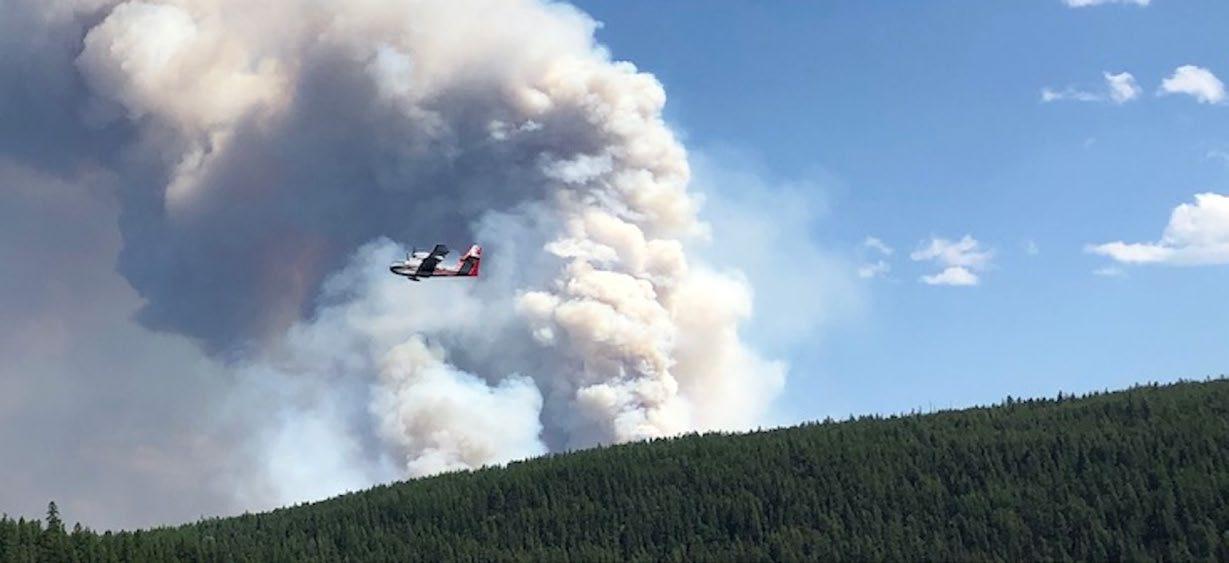
That process would cost the project a delay in many years and cost U.S. taxpayers thousands of dollars in court fees and staff time. Ultimately, after all the money spent and the dust settled in the courtroom, there was no change in the actual onthe-ground treatment units. The fuels reduction, forest thinning, road decommissioning, road rerouting, weed spraying, pile burning, and prescribed burning proposed in the Colt Summit Project still ended up happening, starting around 2014. Though the checks and balances and opportunity for individuals or entities to question government action is certainly an important part of democracy and oversight, projects like Colt Summit are often held up for years in litigation, decrease agency staff capacity towards other projects, and are costly to taxpayers.
After the project timeline and history were presented, USFS District Ranger Quinn Carver, MT DNRC unit manager Kristen Baker-Dickenson, and USFS Fire Management Officer Brent Olson described the timeline and events of the Colt Fire, which started by lightning on July 17, 2023. The fire quickly escaped initial attack suppression efforts, and the extreme fire potential and hazards associated with the densely forested and remote location greatly threatened firefighter safety. Within a few days

a Type-1 (highest level) Incident Command Team was ordered and arrived to manage the fire and support local crews and agencies. They were led by Brent Olson. Priorities for the team were: protecting life (safety of the public and firefighters), protecting priorities at risk (private structures, homes, roads, powerlines, bridges, etc.), and utilizing techniques and tactics with the highest probability of success to keep the fire perimeter as small as possible, considering the other safety and priority factors.
Olson described how during the start of the Colt Fire, there were very few large fires burning throughout Montana, or nationally for that matter. This allowed fire managers to order many resources––fire crews, fire engines, helicopters, airplanes, heavy equipment, etc.––for fire management operations. He emphasized that this is not always the case. If a similar fire were to have occurred in the Swan Valley in August of 2024, for example, resources were spread so thin nationally, due to many large fires throughout Montana, Idaho, Oregon, Washington, and California, that the people and equipment needed would not have been as readily available.
As the team managing the Colt Fire began scouting for safe and effective places to slow the spread of the fire in the eastern direction, where it would spread toward houses in

the Rovero’s meadows and Highway 83 corridor, lo and behold they found the Colt Summit Project Area. They discovered a good road (646 Road), with Colt Summit Project forest thinning treatments in many places along both sides of the road. The fire crews found units from the project that had received prescribed burning, already significantly reducing the wildland fuels. This 646 Road was the same road that was rerouted out of the bottom of Colt Creek, where it had caused sedimentation issues for the watershed and native fish, to a mid-slope area with minimal topography. This road, and the treatments proactively completed with the Colt Summit Project, effectively provided a catcher’s-mitt on the east side of the fire where fire crews could safely, and with minimal preparations, burn out from the road to stop the fire from spreading in that direction. (A burn out is using fire to fight fire in a more controlled manner by burning vegetation during or prior to a wildfire reaching a control feature. Therefore, since the 646 Road was already prepped as a fire line or fuel break, firefighters had the time to prioritize preparing other areas that were less secure.)

After these discussions, the tour group participants traveled to the southern part of the 646 Road to see the effects of the Colt Fire in person. Participants walked approximately ½ mile up the road and had the opportunity to see areas that were burned at high, moderate, and low severity, as well as young forest areas that did not burn during the fire. Though only one year after the fire, green grasses, forbes, and shrubs were already starting to resprout from the blackened ground. Native plants are quite adapted to wildfire and some respond very quickly. Participants also had the opportunity to talk with many incredibly knowledgeable people involved in fire and forest
management in Montana. To finish up the tour, participants drove to the north side of the fire zone to see treatment units from the Beaver Creek Project Area on the Swan Lake Ranger District. These treatment units have the same type of intent as the Colt Summit Project in that they are proactive treatments used to reduce fuels, reintroduce prescribed fires, and protect communities in the south part of the Swan Valley.
The Colt Fire made a significant impact on the Seeley Lake and Condon communities during the summer of 2023. People were evacuated from certain areas and summer plans were changed. But community members lent a helping hand and we got through it. No one, firefighter or public, was killed or seriously injured during the fire and no structures, homes, or buildings were destroyed. That’s a success.
Proactive fuel breaks, like the treatments along the 646 Road were utilized, improved, and expanded upon, making the communities in the area more resilient and prepared for the future. The 7,000+ acre burned area of the Colt Fire will now effectively be a fuel break for the following 15-20 years for the next fire that will inevitably happen. For example, if there is a wildfire in the West Fork of the Clearwater or Beaver Creek drainages sometime in that timeframe, that wildfire will likely stop, slow, or change burning behavior once it runs into the Colt Fire perimeter and fire managers can focus resources and efforts elsewhere.
Fire will continue to be, and always has been, an important and natural part of the forests of the Swan Valley and western Montana. If we want to continue to live sustainably and not at odds with these wild places and forests we love to live in, we must be proactive to create fire-adapted communities that are resilient to the natural fire that has been here long before us.

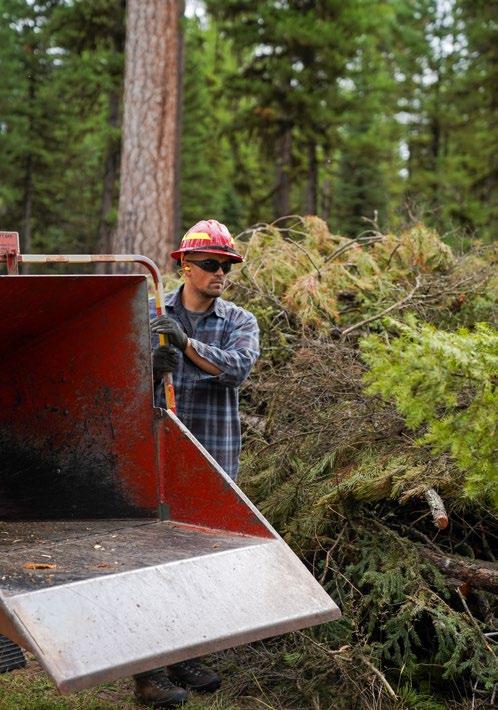

Have an access road much like the 646 Road that you and your neighbors want to treat prior to when a wildfire starts burning? Contact Mike Mayernik at mike@svconnections.org or 406-754-3137 to learn more about SVC’s cost-share fuels reduction program for private landowners, where we often work with alongside local contractors to promote forest treatments that will reduce wildfire risk and increase firefighter effectiveness and safety.
Above: As part of the collaborative Firesafe Swan effort, SVC and the Department of Natural Resources and Conservation (DNRC) worked with residents around Lindbergh Lake to collect brush along roadsides and chip the material. Lindbergh Lake has been identified as a high priority area to reduce fuels, and like so much of what SVC accomplishes, we do it through collaboration and partnerships.
Photos by Emma Merdovic
By Montana Fish, Wildlife & Parks Conflict Technician Mackenzie Taylor

Black bears and grizzly bears continue to expand across the state and many of these bears call the Swan Valley of the Northern Continental Divide Ecosystem (NCDE) “home.”
Recently in the Swan, an adult female grizzly bear was caught and collared for flipping dumpsters. The bear, identified in MT Fish, Wildlife & Parks (FWP) records as #1180, was first captured in the summer of 2023 as a non-target bear and radio collared as part of an effort to determine if she had a history of conflict. The collar unfortunately malfunctioned shortly thereafter and FWP was unable to determine where she moved. For the rest of the summer in 2023 and spring/summer in 2024, there were multiple reports from the same few locals that a radio-collared grizzly bear started to flip dumpsters at local businesses and was getting trash in some residential areas. They also reported that many people were discouraged by certain individual local residents and hesitant to call FWP due to being told that the bear specialists would euthanize the bear, which in this instance is untrue. #1180 was targeted and captured at the beginning of September in Condon, given a new, functioning radio-collar, and was moved to an area around the Hungry Horse Reservoir, where natural bear foods were still abundant. Unfortunately, #1180 is just one bear that FWP was unaware of that escalated her behavior after becoming dependent on trash and flipping dumpsters at several other places. So far this season, FWP has been notified that there have been many other similar situations like #1180 that have gone unreported. Reporting bear conflict when it occurs allows FWP to strategize how to handle the conflict and determine how to best prevent further conflicts based on each bear’s specific behavior. It also allows FWP to collectively implement larger preventative action plans to avert other bears from getting into
conflict and help people by deterring any damage to buildings, structures, storage units, etc.
It should be known that FWP’s goal with bear and lion management is to educate and create good relationships with the public, while managing conflicts and promoting coexistence between people and wildlife. However, when communities are discouraged from reporting a conflict, it not only decreases public tolerance, but it also lessens and limits the options for the bears.
A number of unnatural food sources, including trash, pet foods, grain, and livestock such as chickens, have become easily accessible to bears. This gives them the opportunity to become dependent on these problematic items, which can lead to human-wildlife conflicts. Many of these issues can be mitigated by learning how to properly store and protect these attractants. FWP, as well as Swan Valley Connections, the U.S. Fish and Wildlife Service, and Defenders of Wildlife (among other organizations), can provide the assistance and resources needed to help decrease these human-wildlife conflicts.
If there is a conflict happening with a bear, whether minor or not, it is important to report any occurrences to FWP immediately so that the proper course of action may be taken to get ahead of the potential problem. Doing this helps keep people safe and bears wild.
Conflict can be avoided through a number of practices, some of which include:
• Rolling garbage bins out the morning of pickup. This also includes placing garbage in bear-resistant cans. A common misunderstanding is that these cans are bear-proof, but they are only bear-resistant, which means a bear can still destroy the can over time. Bear-resistant trash cans are
available for free from Swan Valley Connections.
• Taking the garbage to a waste facility whenever possible or storing the garbage in a secure enclosure, which can be an electric fence, shed, garage, or shop.
• Electrifying chicken coops, fruit trees, and storage areas with anything that might attract bears. FWP and Swan Valley Connections can provide temporary fencing and will happily work with landowners to plan and implement permanent fencing structures if needed.
Please report near conflicts immediately to FWP. Addressing initial conflicts promptly can avoid bears from becoming food conditioned or habituated.
In northwest Montana, contact:
• North portion of Flathead County and Eureka areaJustine Valleries, 406-250-1265
• South portion of Flathead County (including all of Condon, Swan Lake, Ferndale, & Bigfork) - Erik Wenum, 406-250-0062
• Cabinet-Yaak Ecosystem and Sanders CountyGarrett Tovey, 406-291-1320
• Flathead Indian Reservation - Confederated Salish and Kootenai Tribes Wildlife Management Program, 406-275-2774
For more information on living, working, and recreating in Montana’s bear country, visit www.fwp.mt.gov/bear-aware. For resources available through Swan Valley Connections, head to www.swanvalleyconnections.org/swan-valley-bear-resources
Addition by Jackie Pagano, SVC Conservation Associate:
In other Swan Valley Bear Resources (SVBR) news, we hosted a variety of outreach events this season, including our annual Bear Wake-up Social at the Swan Valley Community Hall, a Bear Aware and Bear Spray Training at the Bigfork VFW, and a successful Annual Bear Fair this summer at the Swan River Community Hall in Ferndale. SVBR also tabled at the Bigfork Monday Market in June, July, and August, as well as the annual Huckleberry Festival in Swan Lake. Keep an eye out for us at next year’s local events!
In addition to information booths, the Bear Fair featured an informative presentation from guest speaker, Colby Anton. Anton is the Black Bear Monitoring Biologist for MT Fish Wildlife and Parks (FWP), who is now wrapping up year two of a six-year research project, aiming to answer questions on the state’s black bear population, density, habitat, and the effects of hunting throughout the state. A similar research question was posed in 2011, and was first executed in our very own Swan Valley. The model was then expanded across Western and Central Montana to understand overall population health of black bears. As all things evolve, so does technology, thus spawning the desire for the project’s resurgence with a modern twist, using the most advanced tech and methodology available.
Anton’s presentation was just as interesting as it was informative, including detailed depictions of hair-snare corrals and cringe-worthy descriptions of scent lure, or bait, used for the project (think 5-gallon buckets of fish blood, aged and fermented to perfection). Anton concluded his presentation by sharing that his team is always looking for private lands to set bear traps on, and that these opportunities are advantageous for the landowner, who is welcomed to help “work up” any black bear that is caught on their property. SVC offered Anton to set traps on our properties located in Condon. Late this summer Anton, Milan Vinks, and Bruce Montgomery (FWP bear biologists) caught, collared, and released a young female grizzly bear on on an SVC property.

Opposite: MT FWP Conflict Technician Mackenzie Taylor setting up a culvert trap for a grizzly bear who broke into a grain shed, after other conflicts were also reported nearby.
Left: MT FWP Biologist Colby Anton monitorinig the vitals of the young female grizzly that was caught, collared, and released unharmed on the Elk Creek Conservation Area

“Swan Valley Connections has a long history of working to maintain the connection between Swan Valley residents, landowners, visitors and students with this remarkable ecosystem. If you love the Swan, SVC offers a wide range of opportunities to be connected to efforts to learn about and protect it. SVC’s history is one of collaboration, of bringing disparate groups of residents, agencies and organizations together on common ground: our love of the landscape that sustains and enchants us.”
-Mary Shaw, SVC Board Chair
SVC is lucky to have a passionate and engaged Board of Directors. If you’re interested in learning more or filling out an application to be on SVC’s board, please reach out to Sara Lamar (sara@svconnections.org) by December 31, 2024!

Did you know you can leave a lasting impact on the Swan Valley by including Swan Valley Connections in your estate planning?
Multiple options exist, all with benefits beyond supporting the future of SVC and the entire Swan watershed:
• Include SVC in your will, or any Trust you are planning
• Give to SVC’s Endowment Fund, managed through Montana Community Foundation
• Make a Charitable Gift Annuity (CGA) to our Endowment. Montana residents receive extra tax incentives.
• Donate any Qualified Charitable Donation (QCD) distribution, IRA rollover, or distribution.
• Add SVC as beneficiary to any investment or portfolio
As the end of the year approaches, this is a great time to think about tax benefits through charitable giving. SVC is happy to help dream up ideas and connect you with experts in the field; simply give us a call: 406-754-3137. As always, we appreciate you and your passion for Swan Valley Connections’ mission to inspire conservation and expand stewardship.

Silver-haired bats are found from Alaska to Mexico. They’re considered a solitary, tree-roostinig species, and because of this, logging and development are some of their biggest threats.
Mating for the silver-haired bat takes place in the fall, with delayed fertilization happening in the spring, and the birth of twin pups taking place sometime between June and July.
The female will pull her tail membrane forward to create a cradle in which to catch her offspring!
These bats can live up to 12 years, and are one of the slowest flying bat species in North America.
Their scientific name - Lasionycteris noctivagans - translates to “night wandering shaggy bat.”

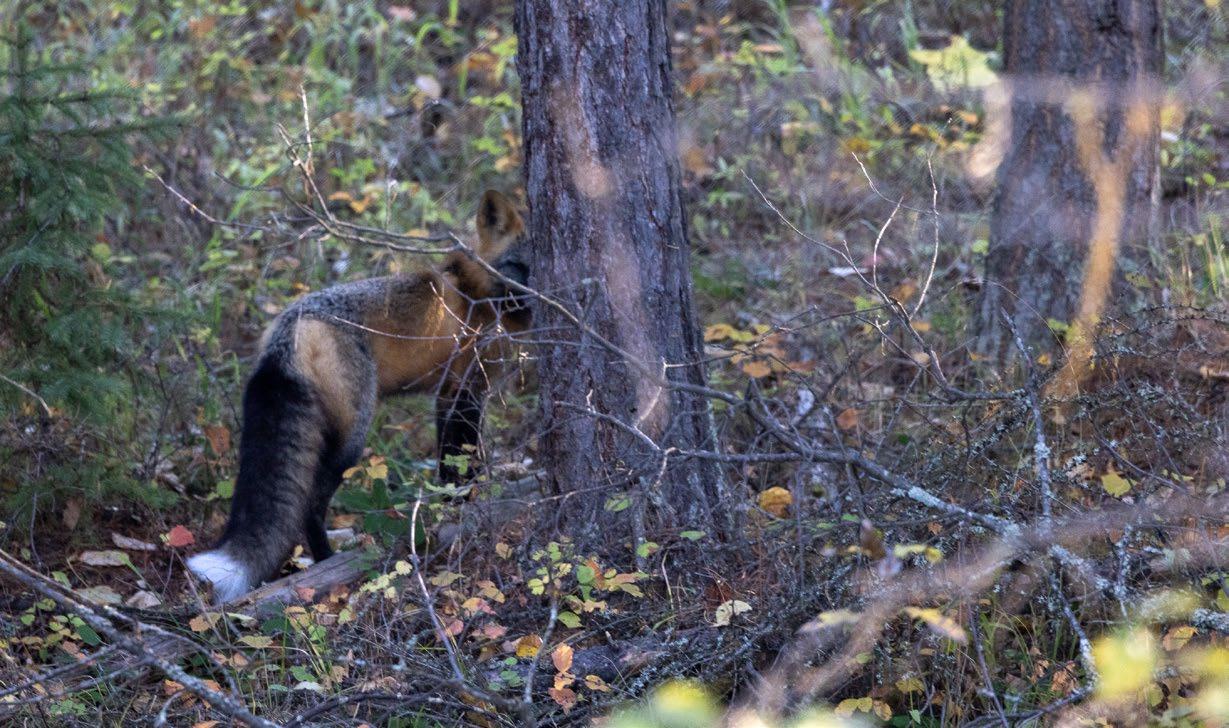
While the most common coat color on a red fox is... well, red, other variations exist, including black, silver, or a mix of two.
A cross fox gets its name from the dark, melanistic stripe going down its back and intersecting stripe over its shoulders, forming a cross.
Cross foxes are more common in northern Canada, although some can be found in the northwestern United States. They prefer less populated areas (like the Swan Valley, where this one was spotted).
The silver-phase red fox, whose fur is totally black with silver tips, is even more rare than the cross fox.

CHANGE SERVICE REQUESTED

Always check our website for more details and the most up-to-date information
November 1-30
Wild for Wildlife
Match Fundraising Campaign
December 1
Winter Programs Scholarship Deadline
December 14
Wildlife Tracks & Sign
december 21 & 23
Annual Audubon Christmas Bird Count & Tally
January 4-12
Weeklong Wildlife Tracks & Sign College credit & CyberTracker certification
january 8
Quarterly Potluck - TBD Swan Valley Community Hall
january 15
First Wednesdays with Swan Valley School: Snow Science
january 15
Spring Programs Scholarship Deadline
january 18
Wildlife Tracks & Sign
january 20
Bubble Cap Orders Open
February 5
First Wednesdays with Swan Valley School: Wildlife Ecology
February 15
Wildlife Tracks & Sign
march 5
First Wednesdays with Swan Valley School: Bears
March 8
Wildlife Tracks & Sign
March 15-23
Weeklong Wildlife Tracks & Sign College credit & CyberTracker certification
APRIL 2
First Wednesdays with Swan Valley School: Birds
APRIL 2
Quarterly Potluck - Spring Bear Wakeup Social Swan Valley Community Hall
